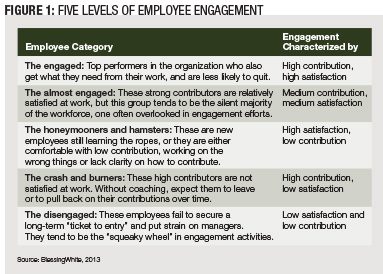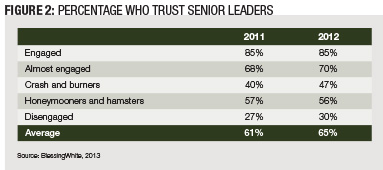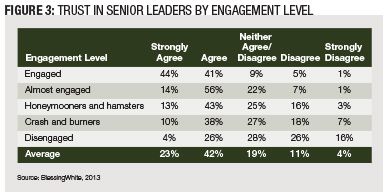If today’s business environment could be summarized in one word, that word would be “fluid.” When an executive team thinks it has the organization under control, it cannot assume that grasp will hold for long; things are changing too fast. Markets shift quickly, product cycles are short, processes are constantly being improved and competitive advantage only lasts as long as a company can innovate faster than competitors. The labor market has become so fluid that younger employees will change employers as readily as they change cellphones.
In this environment of accelerated information and drowning under a barrage of expectations, executives can find themselves trapped in reactive mode. Despite operating under the microscope, senior leaders have to find ways to inspire and help employees engage with the organization’s goals. But trust is fleeting. It is hard to earn and retain.
In consulting firm BlessingWhite’s 2013 “Employee Engagement Research Report Update,” based on the feedback from 7,065 individuals worldwide, research confirms a strong correlation between trust in executives and immediate managers and engagement levels. Trust would be a nice-to-have if it didn’t have a direct impact on the performance of the business. But since BlessingWhite defines engagement as being both high satisfaction at work and high contribution to the organization’s goals — through alignment and effort — there is a strong correlation between those who trust the executives on one side and contribution levels on the other.
Trust in executives is one high-performance component. Senior executives are by default the exemplars, positive or negative, of culture. If they are not working hard to establish trust throughout the organization, learning leaders can’t expect managers or individual contributors to place a high value on trust.
What Is Engagement?
While organizations are keen to maximize each individual’s contribution toward corporate imperatives and metrics, employees need to find purpose and satisfaction in their work. Consequently, BlessingWhite’s engagement model focuses on an individual’s contribution to the company’s success and personal satisfaction in his or her role (Figure 1). Full engagement represents an alignment between maximum job satisfaction (“I like my work and do it well”) and maximum job contribution (“I help achieve the goals of my organization”).

The index BlessingWhite uses to determine engagement levels contains items that reflect two axes: contribution and satisfaction. By plotting a given population against the two axes, five distinct employee segments are identified.
As part of its engagement research, BlessingWhite investigated levels of trust within organizations. The trend is positive, in so far as trust levels in executives and immediate managers alike have improved. But trust is not ubiquitous. At a high level, trust in senior leaders has seen a slight increase between studies from 61 to 65 percent who agree or strongly agree with the statement “I trust the senior leaders of this organization.” This correlates closely to engagement levels (Figure 2).

Broken down by engagement level, the 2012 numbers illustrate a more clear correlation between engagement levels and trust (Figure 3).

The Dynamics of Trust
The way employees perceive and interact with senior executives is different from their relationship with their manager. Managers are judged up close, based on frequent interactions. If employees have doubts about their immediate manager’s motivations or intentions, there are opportunities to put assumptions to the test. Not so with senior executives. For most employees, the senior executive team is distant, seldom seen in person, and their intentions can only be guessed at by reading between the lines of formal communications. As a result, immediate managers may enjoy higher trust levels than executives (Figure 4).

A small number of employees mistrust their immediate manager but nonetheless trust senior leaders. However, a more likely scenario is that the immediate manager has retained the team’s trust despite a lack of trust in senior leaders.
If senior executives do not make an effort to be visible, sharing both the strategy, the logic behind the strategy and their own motivation in driving the organization forward, employees will be left to speculate about the senior team’s intentions. Speculation can be fraught with concern and skepticism.
Learning leaders should make sure senior leaders develop effective communication skills that go beyond communicating dry facts and numbers to appeal to employees’ emotions and passions. Authentic leaders earn trust by sharing personal perspectives and experiences and by becoming known as more than just a title. Senior leaders must look for opportunities in many formats to communicate with the workforce, and provide vision and inspiration.
While executives do not get to interact one-on-one with every employee, their role in building an engaged culture is pivotal. Setting the tone, fostering a purposeful culture and establishing an inspiring vision of the future are all important prerequisites to build engagement across an enterprise.
As leaders continue to communicate across their organizations, they should understand how they are perceived, focusing on their strengths and weaknesses. Do employees find them credible, and do they appear to be living the espoused values? Effective leadership communication is a practice every inspiring leader must develop on an ongoing basis.
Executives are not always in the position to coach and align each employee’s personal interests or skills. They must set the direction the workforce aligns to, communicate that direction to ensure a clear line of sight, and create a culture that fuels engagement and business results. They must fulfill the role of manager with their immediate team and as an individual, and manage their own personal engagement.
Chris Brunone is head of the leadership practice, and Fraser Marlow is head of research for BlessingWhite, a global consulting firm. They can be reached at editor@CLOmedia.com.















